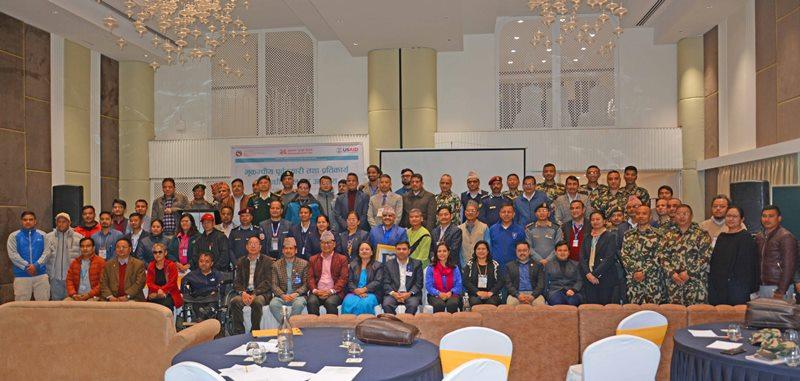
With the aim of improving emergency preparedness and response coordination at the national level, a one-day National Tabletop Simulation Exercise (TTX) based on a major earthquake scenario was conducted on Tuesday, March 5, 2024.
The National Disaster Risk Reduction and Management Authority (NDRRMA) and the Ministry of Home Affairs (MoHA) organized the program, while the National Society for Earthquake Technology - Nepal (NSET) provided the technical assistance with financial support from USAID’s Tayar Nepal project.
The exercise aimed to enhance the capacity of different stakeholders in coordination and information management and develop a common understanding and more clarity on roles and reporting lines. More than 200 participants representing humanitarian clusters, private sectors, security forces, and different levels of government (Federal, Provincial and Local) actively participated in the exercise.
The TTX commenced with a brief opening ceremony. Speaking in the opening ceremony, Mr. Anil Pokhrel, Chief Executive of NDRRMA, emphasized the need for conducting simulation exercises periodically at different levels as part of the disaster preparedness initiative. Mr. Pokhrel remarked, 'Such kind of simulation exercises help in validating the existing SOPs, policy, and plans, and identifying gaps and room for improvements in such policy documents. Therefore, it is imperative to conduct such periodic exercises.
Mr. Bharat Mani Pandey, Joint Secretary, NDRRMA, provided a brief overview of the program, clarified the needs and objectives, and welcomed the participants. 'Preparedness is crucial in Disaster Risk Management. Well-planned preparedness activities help make effective disaster response efforts and minimize the scale of damage caused by any disaster event. That is why the Government of Nepal has conceptualized this sort of simulation exercise, which has been conducted at the district level for years. Today, we are conducting a one-day TTX based on a major earthquake scenario at the central level, to enhance the capacity of different stakeholders in information management and bring more clarity to roles and reporting lines,' Pandey remarked.
The Chief District Officer from Kathmandu District urged all stakeholders to join hands to make our communities resilient against earthquakes and other types of disaster risks in Nepal.
Dr. Ganesh Kumar Jimee, Deputy Executive Director of NSET presented the safety/security briefing and logistic arrangements made for the TTX.
The exercise practiced all issues possibly need to be addressed in the real case, including, assessment, coordination, Search and Rescue, Medical emergencies, camp/shelter for IDPs, coordination and mobilization of security forces, cluster system and international aid etc. through sequentially dispatched injects. To make the exercise realistic and practical in identifying gaps in existing DRRM documents and mechanism, different groups were arranged as planned in the latest version of National Disaster Response Framework (NDRF).
At the end of TTX, a debriefing session was conducted. Mr. Naresh Subba, Brigadier General (Rtd.) of Nepal Army, facilitated the session where all 8 groups (National Council, Executive Committee, National Emergency Operation Center (NEOC), Provincial Emergency Operation Center (PEOC), District Emergency Operation Center (DEOC), and Local Emergency Operation Center (LEOC), Nepal Army Crisis Management Center (NACRIMAC)/ Multinational Military Coordination Centre (MNCC), and On-Site Operations Coordination Centre (OSOOC)) shared experiences and feedback.
Mr. Bharat Mani Pandey, Joint Secretary of NDRRMA and Director of the TTX, presented a brief report incorporating the feedback from all facilitators.
The program concluded with a brief closing session followed by a certification distribution program.
Addressing the closing session, Mr. Anil Pokhrel, Chief Executive of NDRRMA, extended his sincere thanks to various stakeholders for making the event successful and appreciated their efforts.
Ms. Skim Shrestha, Joint Secretary at the Ministry of Home Affairs (MoHA), expressed her belief that the central-level TTX was extremely fruitful and underscored the need for similar exercises at the province and local levels at regular intervals based on the level of disaster risk so that it immensely useful in handling or coping with future disasters.
Rayan O' Donnell, USAID Humanitarian Officer in Nepal, also expressed appreciation for successfully organizing the event. He further shared that the USA is committed to strengthening the capacity of Nepali partners in disaster response and other problems. ‘For more than 10 years, we have worked closely with the government of Nepal to prepare and respond whenever disaster strikes, providing support when needed. The Country Development Cooperative Strategy (CDCS) is the guiding strategy of USAID for Nepal, and under CDCS, the USA prioritizes effective governance, economic development, strengthening the education system, as well as natural resource management in building Nepal’s capacity to respond to and recover from disasters,' he remarked.
On behalf of the UN Resident Coordinator’s Office (UN RCO) in Nepal, Ms. Ayshanie Medagangoda-Labé, the UNDP Resident Representative for Nepal, shared that events like Tabletop Simulation Exercises could prove extremely beneficial in the days to come as Nepal is facing frequent tragic disasters. Mr. Surya Narayan Shrestha, Executive Director of NSET, emphasized the need to incorporate TTX as a regular event for Earthquake Safety Day because it helps DRR stakeholders in Nepal understand and periodically revise the existing National Disaster Response Framework (NDRF), National Disaster Preparedness Plan and Guidelines, response plans, SOPs, policies, and coordination and communication systems.
Image gallery




